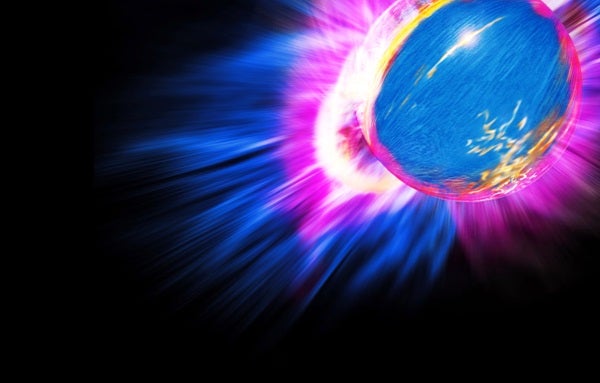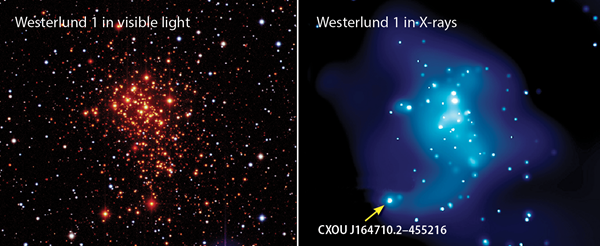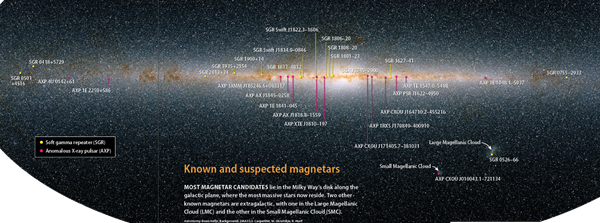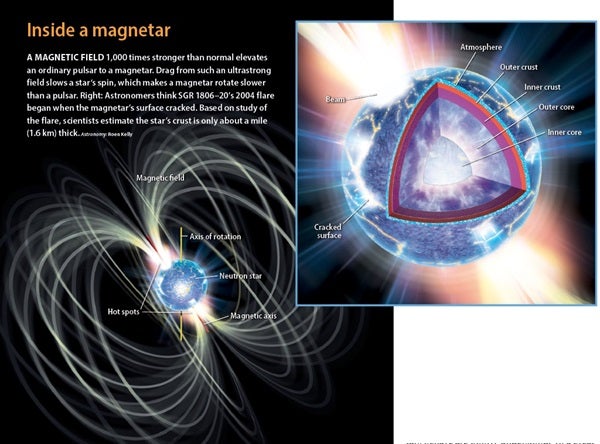In 1987, when Robert Duncan and Christopher Thompson first contemplated the existence of ultramagnetized neutron stars (later dubbed “magnetars”), they had a hard time convincing themselves that the notion made sense. Five years later, when they got their first opportunity to present their ideas at a scientific conference, they were given just three minutes to make their case. Then, in 1998, at a meeting of the American Astronomical Society, Duncan was the last scheduled speaker at the five-day event, seemingly lumped in the fringe category.
Six years later, in 2004, colleagues finally recognized Duncan and Thompson (now at the University of Texas and the University of Toronto, respectively) for their theoretical work on magnetars. Joining them was Chryssa Kouveliotou of the National Space Science and Technology Center (NSSTC) in Huntsville, Alabama, for observations that confirmed the scenario. The three received the Bruno Rossi Prize for outstanding contributions to high-energy astrophysics.
Thus, after almost two decades of doubts, astrophysicists at last acknowledged magnetars are real. These unusual objects constitute a distinct class of pulsars. They are rapidly spinning, intensely magnetic neutron stars — dense remnants of massive stars that expired in fiery supernova blasts.
Armed with this knowledge, researchers then turned their attention to a broad range of questions, such as: Where do these curious objects, with the most powerful magnetic fields known to exist, come from? Or, put in other terms, why do some stars become magnetars rather than black holes or other kinds of neutron stars? Answering these questions can tell astronomers how abundant magnetically powered stars are, thereby providing clues to their astronomical importance.
Blasts from beyond
Scientists now believe magnetars exist because of a confluence of theory and observational data from some of nature’s most impressive high-energy displays. For astronomers, says Thompson, the turning point came in 1998.
In May of that year, a team led by Kouveliotou showed that the soft gamma repeater (SGR) 1806–20, a pulsing X-ray source about 50,000 light-years from Earth, was likely a magnetar. Kouveliotou’s team measured the rate at which the neutron star’s spin was slowing down. A magnetic field could supply the drag to slow the star’s rotation, but it had to be incredibly powerful. The scientists estimated a magnetic field of about a million billion (1015) gauss. (Earth’s magnetic field reaches just 0.6 gauss.)
Then, in August 1998, a powerful blast of gamma rays and X-rays zapped Earth’s outer atmosphere. The burst came from SGR 1900+14, some 20,000 light-years away in the direction of Aquila. Kouveliotou and her colleagues showed, based on the object’s spin-down rate, that it, too, must be a magnetar.
On December 27, 2004, SGR 1806–20 let loose again. The eruption was the most powerful flare from outside our solar system astronomers had ever recorded. In just 0.2 second, the magnetar released more energy than the Sun gives off in 250,000 years.
An international group of astronomers analyzing the December 27 event supported Duncan and Thompson’s hypothesis that magnetar flares arise from twisting magnetic fields. These fields warp and strain the star’s crust, creating shearing stress across a region several kilometers long. This shear zone in some ways resembles a geological fault that gives rise to an earthquake. Eventually, the star’s crust cracks open.
This work answered some questions about the magnetar flares. But where do these overmagnetized neutron stars come from? “You can’t see anything directly related to the progenitor [star] by looking at the flare,” Duncan explains. Nevertheless, he adds, you can get hints simply by seeing where astronomers find magnetars.
Digging deeper for answers
That’s the approach Bryan Gaensler, then of Harvard-Smithsonian Center for Astrophysics, took when he searched the vicinity of a magnetar called AXP 1E 1048.1–5937, located roughly 9,000 light-years away in Carina. “It occurred to me that the environments around magnetars might tell us something about them,” Gaensler recalls.
Gaensler’s team studied the region’s hydrogen emissions using Australia’s Parkes radio telescope and the Australia Telescope Compact Array. The astronomers found a cavity carved out, they think, by stellar outflows from the magnetar’s original star. Knowing that the star’s mass is proportional to the cavity’s size and expansion speed, the team deduced that the progenitor star contained at least 40 times the Sun’s mass.
Donald Figer, then of the Space Telescope Science Institute in Baltimore, probed the connections between magnetars, their masses, and star clusters. Prior to SGR 1806–20’s massive blast, Figer explored a cluster filled with massive young stars that, coincidentally, contained that same magnetar. The most massive stars die first as supernovae, and less-massive stars expire later. Figer inferred that SGR 1806–20’s progenitor had to be bigger than the biggest stars still standing in the star cluster; this implied a mass of at least 50 Suns.
Michael Muno, then of the University of California at Los Angeles, used a similar technique. While surveying the massive star cluster Westerlund 1 with NASA’s Chandra X-ray Observatory, he found an X-ray pulsar lurking in the cluster’s center. Based on the object’s luminosity and spectrum, Muno deemed it a probable magnetar.
His survey showed that Westerlund 1 is teeming with high-mass stars, all roughly the same age. This survey placed a lower limit of about 40 solar masses on the magnetar’s predecessor. It’s intriguing, says Muno, “that we have a good idea of the mass of the star this magnetar came from even though that star disappeared long before X-ray
astronomy began.”
Both Muno and Gaensler believe the association of magnetars with massive star clusters looks strong. Moreover, both magnetars and high-mass clusters are rare, which makes chance alignments less likely.
Muno’s next step was to confirm that his mystery source is, indeed, a magnetar. He observed AXP CXO J164710.2–455216 intermittently over the course of a year using the European Space Agency’s XMM-Newton and NASA’s Chandra X-ray observatories to see how its rotation period changes. This enabled him to estimate the object’s magnetic-field strength. His team calculated a magnetic field of 1014 gauss, which means the object is in fact a magnetar.
Searching star clusters
Figer, now at the Rochester Institute of Technology, undertook an ambitious, five-year project to find all Milky Way star clusters containing at least 1,000 stars, and thus probably 10,000 to 100,000 solar masses of material. To this end, he utilized infrared instruments at the Keck Observatory in Hawaii and aboard NASA’s Hubble and Spitzer space telescopes to probe our galaxy’s dusty disk.
“Our approach,” explains Figer, “was to identify the breeding grounds of magnetars — these massive clusters — and then use pointed observations to see how many magnetars are there.” Once Figer spotted the clusters — nearly 100 in all — others in the team started follow-up X-ray observations with Chandra, looking for pulsing X-ray sources and monitoring their spin-down rates.
By looking at many clusters, Figer’s team hopes to determine the masses of magnetar progenitor stars to within about five solar masses. Such precision is crucial for estimating the fraction of massive stars that develop into magnetars.
How many magnetars might our galaxy host? Figer believes astronomers have seen only a small fraction of the Milky Way’s massive clusters — dust shrouds the rest from view. By extension, this means we’ve discovered relatively few of the galaxy’s magnetars. If Figer is right, the total number in the Milky Way should be between 100 and 200.
90 percent to go
Astronomers also have found a new class of transient magnetars whose X-ray brightnesses can vary wildly. This makes them detectable at some times and invisible at others. A team led by Alaa Ibrahim, then of George Washington University, discovered, with the aid of NASA’s Rossi X-ray Timing Explorer, just such a magnetar in 2003, when the object’s luminosity suddenly increased by a factor of 100. A different group found another strong candidate at about the same time.
Ibrahim shares Figer’s view that the galaxy may host 100 to 200 “live” magnetars. He notes this tally doesn’t include magnetars that have spun down and lost their heightened powers. He believes the elusive transient objects might resolve the discrepancy between the observed and expected magnetar populations. Figer’s team is surveying for exactly this type of now-you-see-it, now-you-don’t object. It’s “trying to see whether there is a population of faint magnetars that hasn’t turned up yet,” says Muno.
Peter Woods, an X-ray astronomer at NSSTC, agrees that pointing telescopes toward massive stars will increase the odds of finding transient magnetars. But identifying magnetars in their “quiescent” state won’t be easy, even with extensive telescope time on Chandra or XMM-Newton. “We don’t know enough about transient magnetars,” he says. “For example, we don’t know their duty cycle — how long they’re bright versus how long they’re dim. X-ray astronomy is only about 40 years old, and we don’t know whether these objects stay dim for 40 years or 100 years.”
Figer doesn’t know either, but he isn’t deterred. “More magnetars are still being discovered, so it would seem we’re not done discovering them,” he says. Rather than relying on estimates of how many magnetars there should be, Figer intends to look and “see what turns up.”
Where are these stars hiding?
The search for magnetars is not confined to our galaxy. In fact, the first known magnetar burst, which was detected in March 1979, came from the Large Magellanic Cloud, a satellite galaxy to the Milky Way. This finding suggests other extragalactic magnetars exist. A flare within 100 million light-years of Earth could be detected with current X-ray and gamma-ray instruments, provided the flare is as bright as SGR 1806–20’s 2004 event, says University of California, Berkeley, astronomer Kevin Hurley. “Since there are many galaxies within this range, we should see these events frequently,” he notes.
NASA’s Swift satellite, which launched in November 2004 to find gamma-ray bursts, can potentially “open up a new field of astronomy — the study of extragalactic magnetars,” says Duncan. For example, on September 6, 2005, Swift spotted a short-duration burst that might prove to be a magnetar flare emanating from a distant galaxy, although not all scientists accept this interpretation.
Swift and other instruments detected a November 3, 2005, burst from M81, a galaxy about 13 million light-years away. This, says Duncan, was “the first identified extragalactic magnetar flare outside the Local Group.” The flare’s energy release appears comparable to SGR 1806–20’s big blast in 2004.
For astronomers hunting magnetars outside of our galaxy, NASA’s Swift is easily the best instrument around. Still, the satellite isn’t optimized for this task. Swift’s detectors are tuned to lower-energy (spectrally “softer”) events expected from neutron-star mergers. “With the right instruments flying,”
Duncan explains, “we could detect a magnetar flare each week. Swift can’t find that many but may still spot an appreciable number over its lifetime.”
The goal, simply put, is to build up statistics, says Hurley. “We’d like to know the magnetar birth rate, which may be difficult to calculate if we’re limited to the magnetars in our own galaxy.”
In addition to computing the fraction of stars that turn into magnetars, researchers would like to ascertain these stars’ properties. Why does one supernova explosion become a magnetar, while another produces a pulsar? The question extends beyond an interest in magnetars alone. “We’re talking about the endpoint of stellar evolution,” Gaensler explains. “If you want to learn about the star cycle and understand what happens when stars die, you need to understand magnetars.”
Mass, the property that most determines a star’s destiny, is definitely an important part of the equation, but it’s not the whole story. To make a magnetar, the core of the pre-supernova progenitor star must rotate rapidly (about 1,000 times per second) at the end of its life. In Duncan and Thompson’s picture, the core acquires its magnetism through a dynamo effect by converting rotational energy into magnetic energy.
The best current models indicate massive stars rotate more rapidly as they die than when they’re young. To wind up as a magnetar, however, the star has to shed much of its mass before it goes supernova, perhaps by expelling it in strong stellar-wind outflows. Stars with high metal content — elements heavier than helium — have stronger winds, Gaensler notes. So, in addition to looking at the masses of cluster stars, scientists should look at metal content, too. “You wouldn’t expect to find magnetars in a low-metallicity cluster,” he says.
To Thompson, the question of the source of magnetars boils down to this: “What kinds of stars end up with rapidly rotating cores?” That’s difficult to say, he notes, “since no one knows how rotation evolves in the center of a massive star.” And although astronomers can measure how fast a star’s exterior is spinning, they still can’t correlate rotation in the outer layer with what’s going on inside.
Given the uncertainties at the theoretical end, perhaps our best recourse is to see where the observations are taking us, Woods notes. Duncan agrees: “Many details of how magnetars behave are poorly understood. To a great extent, theorists are now being led by the observations.” That’s ironic, because when he and Thompson first dreamed up magnetars, there was little evidence the objects existed.
Thompson, for his part, finds it exhilarating to track the magnetar data now coming in. While the findings have supported some of the early views he and Duncan advanced, they also have served to underscore the many puzzles scientists must still resolve.
Fortunately, growing numbers of astronomers are now interested in taking on these challenges. Indeed, many high-energy astrophysicists regard the December 27, 2004, magnetar burst as a watershed event. It’s comparable in significance to Supernova 1987A, the first naked-eye supernova in centuries and the only one from which neutrinos were detected. Recognition of this has brought more attention to magnetars.
“It’s certainly becoming more of a mainstream field, and we’re attracting talented, new people all the time,” Woods explains. “That has led to some nice new results, and it’s only going to get better.”













